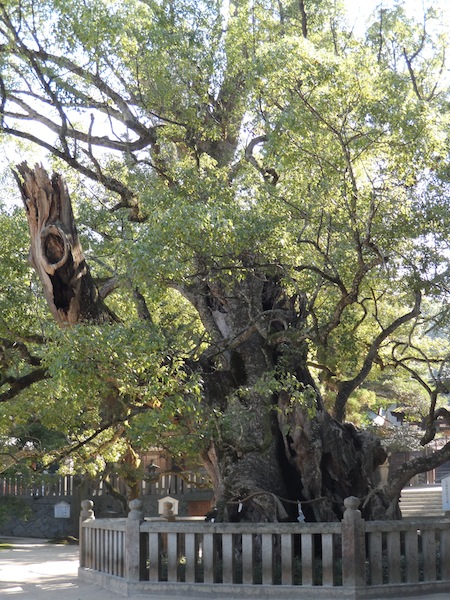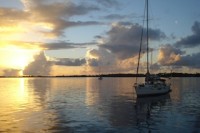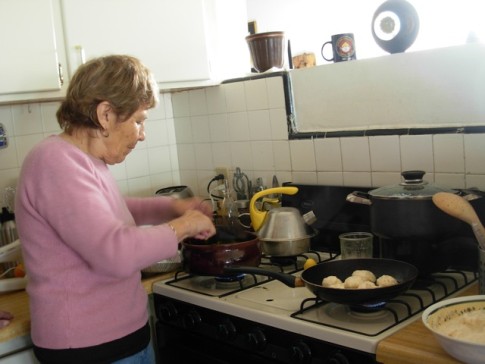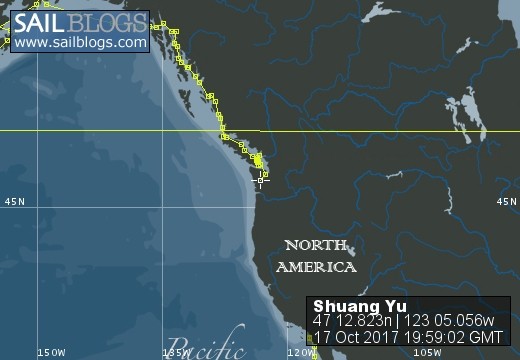
Joy of Cruising
17 October 2017 | Boat position at Shelton: 47°12.82’N; 123°05.01’W
16 October 2017 | Boat position at Shilshole Marina: 47°40.65’N; 122°24.59’W
15 October 2017 | Boat position at Friday Harbor: 48°32.20’N; 123°0.59’W
27 September 2017 | Boat position on Granville Island: 49°16.35’N; 123°08.24’W
26 September 2017 | Boat position on Granville Island: 49°16.35’N; 123°08.24’W
22 July 2017 | Boat position at Granville Island: 49°16.35’N; 123°08.24’W
21 July 2017 | Boat position at Vancouver Rowing Club, Canada: 49°17.77’N; 123°07.85’W
20 July 2017 | Boat position at the Vancouver Rowing Club, Canada: 49°17.77’N; 123°07.85’W
19 July 2017 | Boat position at the Vancouver Rowing Club: 49°17.77’N; 123°07.85’W
18 July 2017 | Boat position in Active Pass: 48°51.64’N; 123°18.54’W
17 July 2017 | Boat position at Otter Cove, Pender Island, Canada: 48°47.84’N; 123°18.51’W
15 July 2017 | Boat position at Port Bedwell, Pender Island, Canada: 48 44.97'N; 123 13.97'W
14 July 2017 | Boat position at RVYC: 48 27.19'N; 123 17.73'W
13 July 2017 | Boat position at RVYC: 48 27.19'N; 123 17.73'W
12 July 2017 | Boat position at SNSYC: 48 40.44'N; 123 25.02'W
12 July 2017 | Boat position at SNSYC: 48 40.44'N; 123 25.02'W
11 July 2017 | Boat position at SNSYC: 48 40.44'N; 123 25.02'W
10 July 2017 | Boat position at Ganges: 48 51.00'N; 123 29.53'W
09 July 2017 | Boat position at Ganges: 48 51.00'N; 123 29.53'W
08 July 2017 | Boat position at Montague Harbour: 48 53.63'N; 123 24.03'W
Omishima, Japan
30 September 2013 | Boat position at city dock at Omishima: 34°14.88 ’N; 132°59.62’E
Pam Lau

Picture: A 2,600-year old camphor tree in the courtyard of Oyamazumi-jinja, a Shinto shine.
The inland waterway was calm and windless so we motored all the way. It took approximately six hours. We passed some beautiful uninhibited islands, industrial factories, and crowded communities. In some places it was like sailing through Venice, Italy, with houses on both sides of a narrow channel. From the water, even the industrial and residential areas seemed to blend into the environment in an esthetically pleasing way.
We left around 10:00 in the morning and arrived at the port of Miyaura in Omishima around 15:00 where a local committee welcomed us and gave small gifts to each of us. After the reception ceremony, Gail and I prepared the evening dinner and lunch for the next day. Later, we were bused to an “onsen”, a public Japanese bathhouse. First, we removed our clothes and showered, and then we entered the actual bathing area. We were overwhelmed with all different the pools filling the large room. There were different sizes, shapes and variance in temperature of the pools. There were even some more in an adjacent room. Dorn, from Australia, was my bathing partner and we started out in the saltwater pool and then went on to others. Some pools had jets massaging our backs and feet while others had waterfalls cascading into the pool. One particular pool was a narrow rectangular shape designed for the bather to walk up and down for exercise, which we did for about ten minutes. A sign provided the recommended times to stay in the water. There were many community members in the bathhouse, including quite a few elderly women. It reminded me of the public steam house in Quinhagak, an Alaskan Yupi’k Eskimo community I used to visit. There, young and old women frequented the hot steam bath for cleanliness and health. It also reminded me of the Korean bathhouse that my sister and I visit each year in California, except there are fewer pools. Also, in California we actually have a masseuse scrub all the dead skin off our bodies before we relax in various rooms filled with herbs, salt, cool air and other healthy substances. Both Japanese and Korean bathhouses have saunas. I like the unique cultural ways of cleansing the body. Being able to experience bathhouses from different cultures is a privilege and an honor.
That evening we had a delicious dinner onboard S/V “Fifth Season”. Gail is a wonderful cook and mindful of nutrition as well. In addition, she is also an extremely talented musician and soprano singer. After dinner she played her harp (built by David, her husband) and sang. The music and her voice were mesmerizing and created a state of complete relaxation of the heart and mind. We felt fortunate to be able to enjoy concert-type performance in the comfort of home in beautiful surroundings.
The following morning we toured one of the oldest Shinto shrines in western Japan, called Oyamazumi-jinja. The deity enshrined there is the brother of Amaterasu, the sun goddess. The buildings date back to 1378 but the courtyard contains a large 2,600-year old camphor tree, much older than the current buildings. Inside, there is a large collection of samari swords, other weapons and armor from all over Japan that date back to 1180 A.D. To find such impressive ancient treasures in Omishima is quite surprising because it is only a small island and sparsely populated. I guess it used to have more residents but many younger people had moved to the big cities for higher education and employment. I guess dwindling rural population is a trend in Japan. I noticed that many hotels, shops and restaurants by the waterfront near the pier were closed, and some were falling down. Our next destination was Onomichi and as we sailed away, our reception committee was there to wave farewell. They were lovely people on a beautiful island, a rewarding stop indeed.
The inland waterway was calm and windless so we motored all the way. It took approximately six hours. We passed some beautiful uninhibited islands, industrial factories, and crowded communities. In some places it was like sailing through Venice, Italy, with houses on both sides of a narrow channel. From the water, even the industrial and residential areas seemed to blend into the environment in an esthetically pleasing way.
We left around 10:00 in the morning and arrived at the port of Miyaura in Omishima around 15:00 where a local committee welcomed us and gave small gifts to each of us. After the reception ceremony, Gail and I prepared the evening dinner and lunch for the next day. Later, we were bused to an “onsen”, a public Japanese bathhouse. First, we removed our clothes and showered, and then we entered the actual bathing area. We were overwhelmed with all different the pools filling the large room. There were different sizes, shapes and variance in temperature of the pools. There were even some more in an adjacent room. Dorn, from Australia, was my bathing partner and we started out in the saltwater pool and then went on to others. Some pools had jets massaging our backs and feet while others had waterfalls cascading into the pool. One particular pool was a narrow rectangular shape designed for the bather to walk up and down for exercise, which we did for about ten minutes. A sign provided the recommended times to stay in the water. There were many community members in the bathhouse, including quite a few elderly women. It reminded me of the public steam house in Quinhagak, an Alaskan Yupi’k Eskimo community I used to visit. There, young and old women frequented the hot steam bath for cleanliness and health. It also reminded me of the Korean bathhouse that my sister and I visit each year in California, except there are fewer pools. Also, in California we actually have a masseuse scrub all the dead skin off our bodies before we relax in various rooms filled with herbs, salt, cool air and other healthy substances. Both Japanese and Korean bathhouses have saunas. I like the unique cultural ways of cleansing the body. Being able to experience bathhouses from different cultures is a privilege and an honor.
That evening we had a delicious dinner onboard S/V “Fifth Season”. Gail is a wonderful cook and mindful of nutrition as well. In addition, she is also an extremely talented musician and soprano singer. After dinner she played her harp (built by David, her husband) and sang. The music and her voice were mesmerizing and created a state of complete relaxation of the heart and mind. We felt fortunate to be able to enjoy concert-type performance in the comfort of home in beautiful surroundings.
The following morning we toured one of the oldest Shinto shrines in western Japan, called Oyamazumi-jinja. The deity enshrined there is the brother of Amaterasu, the sun goddess. The buildings date back to 1378 but the courtyard contains a large 2,600-year old camphor tree, much older than the current buildings. Inside, there is a large collection of samari swords, other weapons and armor from all over Japan that date back to 1180 A.D. To find such impressive ancient treasures in Omishima is quite surprising because it is only a small island and sparsely populated. I guess it used to have more residents but many younger people had moved to the big cities for higher education and employment. I guess dwindling rural population is a trend in Japan. I noticed that many hotels, shops and restaurants by the waterfront near the pier were closed, and some were falling down. Our next destination was Onomichi and as we sailed away, our reception committee was there to wave farewell. They were lovely people on a beautiful island, a rewarding stop indeed.
Comments
| Vessel Name: | Shuang Yu |
| Vessel Make/Model: | Catalina 400 |
| Hailing Port: | San Diego |
| Crew: | Ted Berry and Pam Lau |
| Home Page: | www.sailblogs.com/member/tedandpam/ |
| Social: |

Who: Ted Berry and Pam Lau
Port: San Diego



